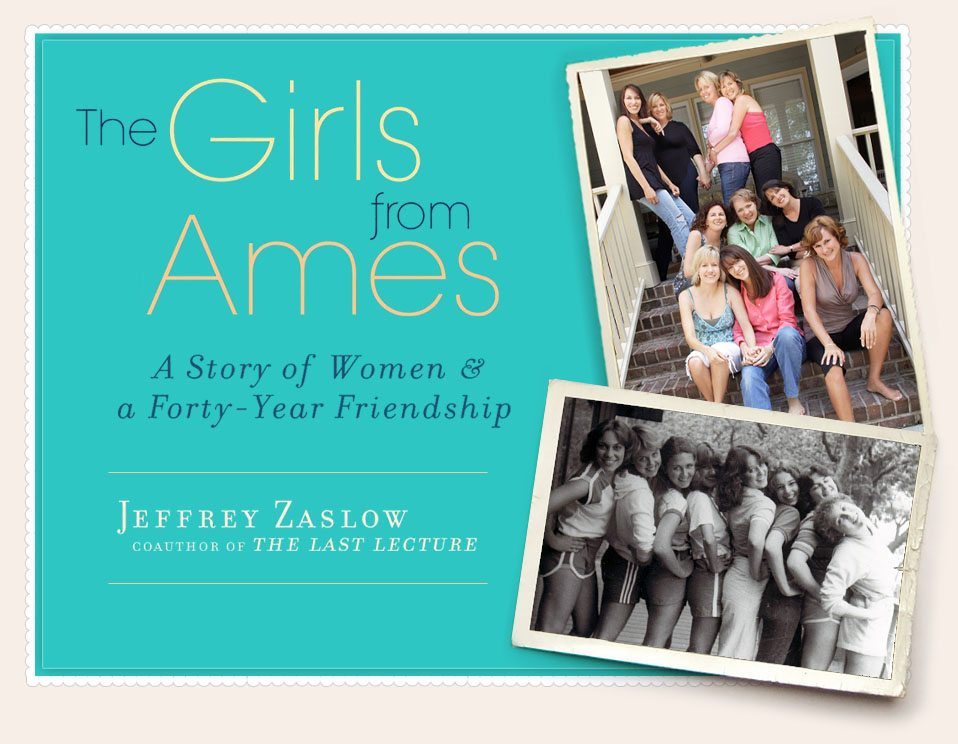A few weeks back I was sent a book in the mail to review, thanks to my connection on TwitterMoms. I was quite excited to get and read the book, the subject matter being near and dear to my heart.
The Girls from Ames: A Story of Women and a Forty-Year Friendship
by Jeffrey Zaslow
from the back cover:
Karla, Kelly, Marilyn, Jane, Jenny, Karen, Cathy, Angela, Sally, Diana, Sheila. Meet the Ames Girls, eleven childhood friends who formed a special bond growing up in Ames, Iowa. As young women, they moved to eight different states, yet they managed to maintain an enduring friendship that would carry them through college and careers, marriage and motherhood, dating and divorce, a child’s illness, and the mysterious death of one member of their group. Now in their forties, the girls have a lifetime of memories in common, some evocative of their generation and some that will resonate with any woman who has ever had a friend. Capturing their remarkable story, The Girls from Ames is a testament to the deep bonds of women as they experience life’s joys and challenges – and the power of friendship to triumph over heartbreak and unexpected tragedy.
I have been blessed to have a very special friend whose friendship has spanned about 25 years now. So this story of, not one woman and her best friend, but ELEVEN best friends, all still enjoying a close friendship after more than 40 years, was intriguing to me.
In the book’s introduction, I was most struck and surprised by the fact that the book is in fact written by a man, a man who didn’t know these women at all in real life before he decided to tell their story. Jeffrey Zaslow first heard about this story from one of the women themselves via a letter to him as a columnist for the Wall Street Journal. He was so compelled to share their story that he took a WHOLE year off from his writing job at the Journal to immerse himself in their lives. And being a man meant that he took nothing for granted, often asking questions that a woman would never have thought to ask, thus giving him an uniquely objective perspective from which to tell their story.
Zaslow heard about many such stories from other women, expressing how their special friendships had been what had kept them going through so many things in life. But he felt like this story was different in some ways, being so broad in scope (11 girls!) and having continued in many ways unchanged for so long. He was given countless examples from these girls of how close female friendships can shape every aspect of women’s lives.
Not many of these 11 girls can actually articulate when they met each other, most of them having memories of each other from even before they can remember other things. They grew up in the same town, for the most part, and experienced the same things with each of their families, so they share a collective memory of happenings and events that seemed to form the foundation of their friendship. Or perhaps I should say friendships…
Their group provided a testing ground for them to bounce ideas off one another, to experiment with their individuality, and yet to always be accepted, even when specific activities were perhaps not condoned by the whole of the group. Each girl had her very specific place and role, and some girls were closer than others, but in their minds, it is, was, and always has been all 11 of them, all together.
The group was a safe place for them through their teen years in the 1960s, and those shared experiences solidified their identity as a group, while also further helping them to define themselves as individuals. They were steadfast confidants, even through disagreements and fights over boyfriends and such – what happened in the group, stayed in the group, and what was shared in the group also stayed in the group, no matter what.
They weren’t always popular with other girls, and became more and more aware of the fact that they had somehow become an ‘exclusive’ group and were often seen as a clique by many outside the circle. If any of the other girls at Ames High School had any notions of joining them, the “Shisters”, as they became known, were too absorbed with themselves to ever notice – not out of rudeness or snobbishness, but just because they were them, and that is who they went on being.
Like so many young girls, when they graduated from High School, they all had warm fuzzy feelings of being friends forever. One of the fathers gently told his daughter that they would all move on and find the friendships waning over time. She assured him that he was wrong – they would always be together. Somehow she just knew it.
And she was right!
From the time that they left their parents’ homes until now, these women have made it a priority and found a way to stay connected through all the years, all the ups and downs of life, all the moves and changes that have come their way. Once or twice a year at least, every year, without fail, they have gathered together somewhere to share life, all of them together. Plus the countless phone calls, e-mails, letters and other visits that all happened along the way.
The girls, as they STILL call themselves, have many roles as adult women: stay-at-home-mom, psychology professor, accountant, makeup artist, teacher, assistant dean of a medical school, owner of a PR firm. Their walks of life have been as individual as they are, reaching far beyond their circle, and yet THEY are the constant in each others’ lives, and the circle remains of utmost importance to them, to this day.
The easy-to-read 330 page biography-of-sorts shares about each of the girls individually, and how her thread weaves through the tapestry of this amazing friendship, in beautiful detail. Insights for such detail were provided in part by the girls’ own letters and pictures, saved from their passing-notes-in-class days and documenting ordinary shared experiences that piece together an extraordinary story.
In Zaslow’s words, “they believed their friendships thrived [especially through the years when they have been separated by distance] because they had raised some expectations and lowered others. They had come to expect loyalty and good wishes from each other, but not constant attention. If a friend didn’t return an e-mail or phone call, they realized, it didn’t mean she was angry or backing away from the friendship; she was likely just exhausted from her day.”
These words were particularly meaningful to me, because my special friendship that I mentioned at the beginning has been characterized by those exact words. The love, acceptance, and sense of belonging that I’ve been blessed to have shared with my friend have shaped a large part of who I am today. And that ongoing relationship has been priceless, even when we may not talk on the phone for a year, and we may not exchange e-mails for a few months at a time. When we do connect, we always pick up right where we left off, without having to make excuses for our absence, but happy to catch up with each other, and always there to cheer one another on.
I know the impact of 1 such best friend, and I can only imagine the beauty of having 10 such best friends.
The Girls from Ames is an inspiring story, a story that gives me hope as I look at my daughter and her friendships. Not every group of friends will be able to endure this way. But even if only 1 friendship between 2 girls lasts, and comes anywhere close to what these 11 Iowa girls experienced, the women in that friendship will be stronger and better people because of it.
I can’t wait to give this book out as gifts to several friends and family members. It really is a treasure. I hope it spurs some women on to hold on to their friendships in this way: with expectancy and good-will toward one another, letting go of the expectations and criticism, and pressing on for the long haul together, through thick and thin, just loving and accepting one another right where they’re at. These are the kinds of friendships that change women’s lives for the better.
And those women go on to do amazing things with their friends at their sides, even if they live half a world away. The Girls from Ames prove that in so many ways!
The book for this review was provided to me, at no cost, by the Penguin Group for the sole purpose of providing a review. I did not accept monetary compensation for reviewing or writing about this book. I only review products that I have personally tested and used (or read) in my home, and all opinions expressed are my own.








I just ordered this book and can't wait to read it! I can totally relate, I have a group of seven girlfriends who have been friends since childhood. One of the girls mom was the kindergarten teacher to 3 of us, that's how it all started. How many women can say their kindergarten teacher attended their wedding? I can think of at least three! We even have a collaborative blog together: http://www.lylasandco.com/
Liz, thanks for stopping by my blog. I loved loved loved the book "The Girls from Ames". It's awesome to hear that you have had a similar 'girlfriend' experience, and I'm interested to read your blog.
I just wonder, does LYLAS mean "Love You Like A Sister" or does it stand for something else? My best friend, the one I mention in the book review, and I always end our letters, STILL, with LYLASA (Love You Like A Sister Always). Just thought your letters in the blog address looked very familiar!